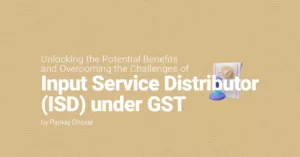
Starting from The United Nations Framework Convention on Climate in 1992, Kyoto Protocol in 1997, L ’accord de Paris in 2015, COP 26 in Glasgow 2021 and COP 27 in Egypt 2022 – where the international community agreed to work towards the common aim of limiting the Greenhouse gases (GHG) emissions, the fight against climate change has led to significant developments over the past decades. It was at Kyoto that participating countries set up the target to restrict and control the emission of GHG by setting emission reduction targets. With that aim in mind, at COP 26 participating countries agreed to take significant steps towards future of carbon markets.
Countries and Multinational National Corporations (MNCs) across the globe have been developing strategies for lowering GHG emissions and achieving a net-zero position. MNCs are evolving strategies to different regulations across different countries in the form of carbon taxes and emission trading systems, and various disclosure requirements.
MNCs are making large investments to meet their environmental and sustainability goals. Accordingly, their transfer pricing issues are gaining importance. These issues include but are not limited to change in supply chain structure(s) to make it more environment efficient, how to allocate the costs associated with environmental advancements, implementation of best structure for sourcing or trading carbon offsets etc., depending on the MNCs objectives and net emission goals.
This article discusses carbon trading and its considerations which will affect the transfer pricing strategies and policies of the MNCs.
What is Carbon Trading
Carbon trading has been a hot topic in the world of business and sustainability for a couple of years now. Carbon trading is a tool that businesses can use to offset their carbon emissions and reduce their overall carbon footprint. It is seen as an effective way to reduce GHG emissions and help companies achieve their carbon reduction goals.
To simplify, Carbon trading involves a system of trading carbon credits. Carbon credits are legal tradeable certificates that permit right to emit one ton of carbon or carbon dioxide equivalent. Companies that have reduced their GHG emissions can sell their credits to other companies who may not have been able to reduce their emissions to the same extent. This purchase of carbon credit exhibits carbon offsets. Carbon credits can be traded in international markets at prevailing market prices. This system helps incentivize companies to lower their emissions and rewards those who have made efforts to do so.

At group level, carbon trading helps groups to minimize their overall group carbon tax liability i.e., in countries where carbon taxes are levied, companies can use transfer pricing planning and intra group carbon offsets to minimize their group carbon tax liability.
Carbon Trading across the world
There are several carbon trading markets operating around the world, both Compliance (Regulated) and Non-Compliance (Voluntary). Compliance markets are created owing to policy or regulatory requirements. Under this market, credits are underlined by verification and regulatory processes, and are widely traded on national and international markets. Some of the largest compliance carbon markets in the world include The European Union Emissions Trading System, China’s Emissions Trading System, The Regional Greenhouse Gas Initiative in the United States, The New South Wales Emissions Trading Scheme in Australia etc.
The prices of carbon credits in compliance markets can vary depending on factors such as supply – demand for credits, the severity of the emissions reduction targets, and the general economic outlook. As more and more companies are looking to reduce their emissions, the prices of credits are seeing an upward trend.
Voluntary carbon markets have developed independently of government targets and policies. It provides a market for companies to buy and sell carbon offsets. Some of the voluntary carbon markets in the world are The American Carbon Registry, The Climate Action Reserve etc.
The prices of carbon credits in voluntary markets can also vary depending on factors such as the type of project that generated the credits, the quality of the said project, and the demand for credits from buyers.
In India, at present, Carbon is being traded on India’s Multi Commodity Exchange. However, Ministry of Power released a draft of the Carbon Credit Trading Scheme (CCTS) in March 2023. The draft establishes the institutional framework and mechanisms for the functioning of the Indian carbon credit market. The scheme will likely cover a number of sectors including power, industry and transportation, and the government is likely to set a cap on emissions for each sector. It will be a compliance market and the prices will likely be determined basis supply and demand.
How it may lead to restructuring in an MNC
Stakeholder concerns, disclosures and financial disincentives are pushing MNCs to lower their GHG emissions. MNCs are likely to build green teams – in the form of people having expertise in carbon dealings – like central carbon team (for the purpose of this article, let’s call specialised central carbon team as ‘green team’).
To effectively manage intra-group transfers and transfer pricing, many MNCs are in process of establishing their green teams if not already. One approach to carbon trading is through intra-group transfer pricing planning, where companies can use the carbon credits generated by one division to offset the emissions of another. This process allows companies to utilise carbon credits generated internally, rather than purchasing them from external entities.
Green team shall monitor carbon emissions and credits, provide guidance and supervision to ensure that the carbon credits are generated correctly and that all divisions of the company are utilising them effectively. This approach can also help increase the efficiency of the company’s sustainability strategy, leading to cost savings and improved performance.
Role of Transfer Pricing in structuring
The concept of intra-group transfer pricing is not new, however, its application to carbon trading is a recent development and something to keep an eye on. The following paragraphs discusses considerations to deliberate before setting up transfer pricing policies for services provided by the green teams.
First and foremost, let’s understand what functions shall be provided by the green team. In simple words, green teams are expected to have functions like understanding the carbon markets, executing transactions like purchase and sale of intragroup carbon credits, verification of earned credits, purchase and sale of carbon credits on the markets, managing compliances for the group, ensuring that group maximises returns from carbon trading and minimises emissions, have specialised knowledge of the industry, stay abreast with evolving regulations, assist internal teams in accounting and legal issues etc.
Given the above, dealings with green team can be divided into following two major buckets of transaction:
-
A. Trading Activities: Acting as a group trading entity
As a group trading company, green team shall perform functions such as buy and sell of carbon credits, maintain surplus inventory of carbon credits to meet the future demands, provide financing services, performing hedging functions, advising group entities on ways to reduce emissions, etc. Each service provided by the green team needs to be identified and remunerated in a manner that is consistent with the arms’ length principle.
While designing transfer pricing policy for above, following points should be considered:
-
MNCs should consider appropriate market prices of carbon credits (like spot pricing or norm pricing, if available) while undertaking the trading activities.
-
Where the green team provides financing (in the form of extra credit period etc.), the MNC may consider adding an appropriate market interest rate for the extra credit period in the above-mentioned market price
-
Intra group services' paragraph discusses considerations for intra group services.
It is important to consider that, where green team acts as a full risk bearing trading entity. The purpose of this entity is to earn additional income for the MNC. However, as a full risk bearing entity the green team may also incur losses. Accordingly, it is critical to ensure that green team is equipped to bear these risks and employs qualified team with specialised knowledge.
-
B. Intra Group Services: Acting as a Service entity
Certain services provided by green team shall be administrative in nature such as assisting internal teams in accounting and legal issues, managing administrative compliances etc. Whereas certain services shall be specialised in nature such as strategizing minimising emissions, pooling services, facilitating buying and selling of credits as an agent etc.
Accordingly, the group transfer pricing policy is required to ensure that services are appropriately identified, and their related costs are appropriately allocated within the group in accordance with the arms’ length principle.
For specialised services it will be important to establish the functions, assets, and risk of the green team and accordingly arms’ length renumeration should be fixed.
The MNC may consider a cost-plus model. An arms’ length margin may be fixed and updated annually. For allocation of cost, MNC may consider the following allocation keys such as:
-
Respective carbon emission goals. For instance – manufacturing entities of the MNC has goal of reduction of 50 tonnes of GHG emissions annually, whereas service entities of the entity have goal of reducing 10 tonnes of GHG emissions annually.
-
Respective buy-sell basis i.e., carbon credits bought and sold. For instance, total units bought and sold by the group entities may be considered as an allocation unit.
-
A hybrid of both -where certain part is fixed depending on carbon emission goals while remaining is fixed depending upon carbon credits bought or sold. For instance, MNC may follow 50-50 ratio of carbon emission goals and buy sell basis for allocation key. Allocation key may be fixed 50% of individual emission goals and 50% of respective buy sell units.
It is important to note that, the selection of the appropriate allocation key will depend on the individual facts of the case like in the industry group is working in, the supply chain of the transaction, nature of the services etc.
Let’s take example of green team acting as service provider in the form of buying/selling agent. In this case green team may be required purchase carbon credits from open market or purchase by moving carbon credits among different related parties. In the given case, the green team does not own the carbon credits, it is a service provider that facilitates transfer of internal resources or arrange from external resources wherever required and perform related compliances. The team performing such functions is expected to have expertise in such functions. An important consideration while fixing the arms’ length remuneration shall be to identify which entity bears the market risk for fluctuations in price of carbon credits. In the given case, green team may consider a cost-plus model. An arms’ length margin may be fixed. For allocation of costs, MNC may consider allocation keys on either buy sell basis or a hybrid basis.
For administrative services such as assistance in accounting and auditing etc, the MNCs may also consider electing simplified approach of low value-added services in accordance with OECD Transfer Pricing Guidelines 2022. It will reduce compliance effort and cost and provide greater certainty to the MNC.
Other factors that need to be considered while designing the appropriate transfer pricing policy for green team are as follows:
-
First and foremost, we need to consider that, the transfer pricing policy decisions regarding services from green team shall be considering the underlying business of the MNC and different regions in which they operate. For example, transfer pricing policy for green team of consulting services shall be different from a manufacturing company.
-
It is not far-fetched to state that to minimise the GHG emissions and to achieve carbon neutrality, it is expected that the MNCs shall go through global business restructurings –movement of people within the groups, change in location of manufacturing units, introduction and developments of new technologies, etc. All these issues will also have transfer pricing implications and same need to be considered and planned carefully.
-
Last but not the least, while deliberating the structure it is required that condition of economic substance is met. It is critical to ensure green team has the ability in the form of specialised team and decision-making powers. The compliance with the necessary economic substance requires not only that green team is localized in the company jurisdiction but that effectively the decisions and meetings are taken and held in the relevant jurisdiction.
Conclusion
The world is changing, and so are the challenges we face. One of the greatest challenges we face as a global community is climate change. Carbon emissions contribute significantly to climate change, and businesses around the world are beginning to take responsibility for their carbon footprint. It is encouraging to see companies around the world taking a proactive approach to reducing their carbon footprint.
With the help of green teams and carbon offsetting, businesses can take meaningful steps towards minimizing their overall group carbon tax liability while also creating a greener future for all.
In summary, carbon trading can be an effective way for companies to reduce greenhouse gas emissions and at the same time, minimize their overall group carbon tax liability. However, it requires careful planning and management of transfer pricing policies for intra group transactions such as transfers, services etc., to ensure compliance with regulations and best practices. Proper transfer pricing strategy ensures that intra-group transactions are priced fairly and in line with independent scenario. With the right strategy and team in place, carbon trading can help businesses achieve their sustainability goals and reduce their carbon footprint.

Aditi Mehra
Aditi looks after transfer pricing in specific in her role as Senior Manager and has spent a little shy of a decade with Coinmen. A Chartered Accountant with a diploma in International Taxation and Transfer Pricing, she’s a self-professed ESG enthusiast.










